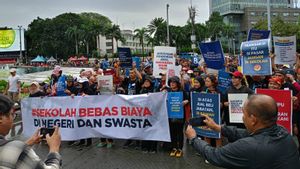JAKARTA Generation Z (gen Z) is again in the spotlight. A total of 9.9 million generations are unemployed. Gen Z is claimed to be a generation that is picky about work, but if viewed further, the problem is more complex than that.
The Central Statistics Agency (BPS) noted that as many as 9.9 million Indonesians aged 15 to 24 years or called gen Z are unemployed or fall into the category of Not Employment, Education, or Training (NEET).
In addition to showing serious problems in the transition of the younger generation to higher education and labor markets, this figure also has the potential to hinder the use of demographic bonuses and achieve the vision of Indonesia Gold 2045.
In short, the demographic bonus is a term used to describe where a country has a relatively large population of productive age compared to the number of people of unproductive age, namely children and the elderly.
Demographic bonuses occur when birth rates decrease while people's expectations and welfare increase. This phenomenon allows a country to strengthen its economy and improve the quality of life of its population. Indonesia is currently on the verge of a demographic bonus which is expected to last until 2030.
But seeing the high number of Z genes that are not in college and do not work, it shows that Indonesia is not yet fully ready to take advantage of the demographic bonus.
The high unemployment rate among gen Z seems to emphasize that they are a generation of lazy and picky about work. These labels are often associated with their difficulty in getting jobs in a more competitive labor market. Is that true?
The answer is not either. According to the Kompas Data Report, there has indeed been a downward trend in the creation of formal jobs over the past 15 years. In the 2009-2014 period, formal job creation reached 15.6 million. This figure fell to 8.5 million in the 2014-2019 period, and was running low in the 2019-2024 period with only two million formal job creations.
This claim was strengthened by the statement by the Deputy Chairperson of Apindo for Manpower, Bob Azam. According to him, the current five percent economic growth is only equivalent to the absorption of one million workers. Whereas in the heyday of the manufacturing industry in the 1990s, every one percent of economic growth is equivalent to the absorption of 600 thousand workers.
In fact, the number of new workforces can reach 2.5 million people per year. This means that the number of employment personnel is far less than the number of new workforces.
Apindo Chairman Shinta Kamdani said that in the last nine years the absorption of labor in the industrial sector in Indonesia has shrunk. In 2013, said Shinta, every investment that comes in worth IDR 1 trillion could absorb 4,594 workers. However, in 2022 each investment worth IDR 1 trillion was only able to absorb 1,081 workers.
SEE ALSO:
This happens because in recent years investment tends to be capital-intensive, not labor-intensive, so it only absorbs a little labor. No wonder the labor-intensive manufacturing sector has many layoffs, aka layoffs.
Launching the Ministry of Manpower, in September 2024 there were an additional 6,753 layoff victims. Thus, since January the total number of workers affected by layoffs has reached 52,933.
"In addition, digitalization and automation are also caused, so that labor absorption is reduced and the types of jobs needed with higher abilities and change," said Shinta.
Ida Fauziyah, former Minister of Manpower, once said the government was continuing to encourage efforts to overcome the high unemployment rate, including among Gen Z, which turned out to be mostly from graduates of Vocational High School (SMK).
According to Ida, one of the main causes of unemployment among vocational school graduates is the discrepancy between skills obtained in schools and job market needs (mismatch).
"I have often said it because our unemployment is mostly contributed by vocational high school graduates, children who graduated from vocational schools. This is because it is amissmatch," he said on May 21, 2024.
Meanwhile, the coach guidance lecturer at the Catholic University, Widya Mandala (Unika Wima), Felix Trisuko Nugroho, M.Pd, gave his views on claims that Gen Z was picky in finding work.
According to Trisuko, Gen Z tends to be more selective in choosing jobs than the previous generation. Not only looking for jobs with high salaries, but also jobs that give meaning, opportunities to develop, and balance of work life.
In addition, Felix also said, Gen Z's demands and hopes for the work environment are also different. They want flexibility, opportunity to work remotely, and the company's culture that is inclusive and supportive.
"This tendency is often misinterpreted as a picky attitude, when in fact they only want a work environment that is in accordance with their values and aspirations," he explained.
But this picky attitude of work can be an old-edged sword, Felix said. On the one hand, this selectivity can help them find jobs that are truly satisfying. But on the other hand, it can prolong the work search process and make them appear less comprehensive in the eyes of employers.
However, Felix agreed that the difficulty of Gen Z in getting a job was not solely due to being picky.
"Other factors such as discrepancies between their skills and work market needs, a lack of work experience, and increasingly fierce competition also play a major role in this," he said.
The English, Chinese, Japanese, Arabic, and French versions are automatically generated by the AI. So there may still be inaccuracies in translating, please always see Indonesian as our main language. (system supported by DigitalSiber.id)














